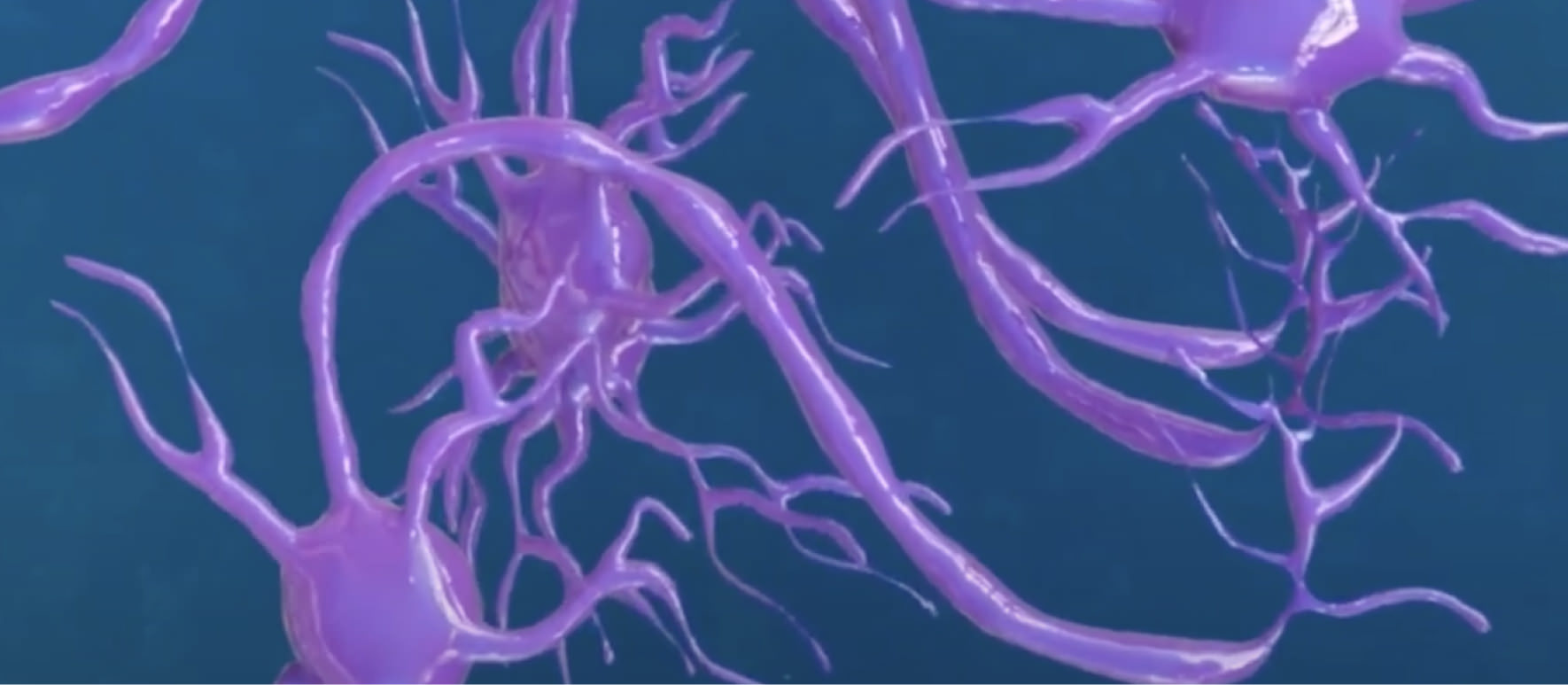Canavan disease (CD) is a rare genetic neurological disorder characterized by spongy degeneration of the white matter in the brain.
Myrtelle’s clinical program for Canavan disease is the first gene therapy to specifically target oligodendrocytes. rAAV-Olig001-ASPA has been granted Orphan Drug, Fast-Track and Rare Pediatric Disease Designations for the treatment of Canavan disease in the US, with similar designations in Europe.

Through our core technologies and expertise, we have built a platform to address myelin-based disorders. Myrtelle’s next-generation Canavan gene therapy (rAAV-Olig001-ASPA) is the first gene therapy designed to target oligodendrocytes, cells which are critical for myelination and nerve function. Improvement of ASPA function in these cells is intended to reduce concentrations of N-Acetylaspartate (NAA) and produce other positive benefits, allowing myelination to occur.
Learn More About Our TrialCanavan disease (CD) is a rare genetic neurological disorder characterized by spongy degeneration of the white matter in the brain.
Estimates of the incidence of CD range from as high as 1:6,400 to 1:100,000 live births in various populations around the world.
Motor function is severely impaired and worsens over time. Symptoms include poor head control, eye tracking difficulty, excessive irritability, abnormally large head size, and delays in motor and developmental milestones. Progressive symptoms include seizures, spasticity, difficulties in swallowing, and overall muscle deterioration. Life-threatening complications usually occur by 10 years of age.

Myrtelle’s Phase 1/2 clinical trial of a proprietary gene therapy for Canavan disease (CD) utilizes a proprietary recombinant adeno-associated virus (rAAV) vector that for the first time directly targets oligodendrocytes in the brain. Oligodendrocytes are the cells in the brain responsible for producing myelin, the insulating material that enables proper function of neurons. The production of myelin is affected in CD due to a mutation in the Aspartoacylase gene (ASPA). As a result, patients are affected at birth but may appear normal until several months, when symptoms begin to develop. Poor head control, abnormally large head size, eye tracking difficulty, excessive irritability, severely diminished muscle tone, and delays in reaching motor milestones such as rolling, sitting, and walking are typical.
As the disease progresses, seizures, spasticity, difficulties in swallowing, and overall muscle deterioration emerge, with most affected children developing life-threatening complications by ten years of age. The oligodendrocyte-targeted gene therapy is intended to restore ASPA function, thus enabling metabolism of the chemical N-Acetylaspartic Acid (NAA), a chemical abundant in the brain, and supporting myelination. Currently, there is no cure for CD and only palliative treatments are available.

Canavan Disease is a rare genetic disorder that primarily affects the central nervous system. It is classified as a leukodystrophy, which means it primarily involves the degeneration of white matter in the brain.
Canavan Disease is caused by mutations in the ASPA gene, located on chromosome 17. This gene provides instructions for producing an enzyme called aspartoacylase, which is essential for the breakdown of a substance called N-acetylaspartic acid (NAA). Mutations in the ASPA gene result in the accumulation of NAA in the brain, leading to the destruction of myelin, the fatty substance that covers and protects nerve fibers.
Symptoms of Canavan Disease usually become apparent in early infancy, typically between the ages of 3 to 6 months. However, the age of onset can vary, and in some cases, symptoms may appear later.
No, Canavan Disease is not contagious. It is a genetic disorder caused by inherited mutations, and it is not spread through contact with affected individuals.
Canavan Disease is referred to as a white matter brain disorder because it primarily affects the white matter of the brain. White matter consists of nerve fibers (axons) covered by myelin, a fatty substance that facilitates the transmission of nerve impulses. In Canavan Disease, the degeneration of the white matter is a prominent feature, leading to the loss of myelin.
Common symptoms of Canavan Disease include: Abnormal muscle tone: Hypotonia (decreased muscle tone) is often observed. Developmental delays: Delayed development of motor skills and speech. Macrocephaly: Unusually large head size. Seizures: Some individuals with Canavan Disease may experience seizures. Feeding difficulties: Problems with feeding and swallowing may arise. Lack of head control: Difficulty in controlling head movements. It’s important to note that the severity of symptoms can vary, and individuals with Canavan Disease may experience a range of cognitive and physical challenges. The course of the disease is generally progressive.
Canavan Disease can be diagnosed through a combination of clinical evaluations, imaging studies, and genetic testing. The diagnostic process may include: Clinical Evaluation: A healthcare professional may assess the child’s developmental milestones, neurological symptoms, and conduct a physical examination. Brain Imaging: Magnetic Resonance Imaging (MRI) of the brain can reveal characteristic abnormalities, including white matter degeneration. Genetic Testing: DNA analysis to identify mutations in the ASPA gene, which is associated with Canavan Disease, is a key diagnostic tool.
The symptoms of Canavan Disease can be noticeable, particularly in the early stages of infancy. However, the disease can share some features with other neurological disorders, making it essential for a healthcare professional to conduct a thorough evaluation for an accurate diagnosis. Some of the distinctive signs, such as abnormal muscle tone and developmental delays, may prompt further investigation.
Yes, genetic testing is available for Canavan Disease. This involves analyzing a person’s DNA to identify mutations in the ASPA gene. Genetic testing is a crucial and definitive method for diagnosing Canavan Disease, especially in families with a known history of the condition.
The N-acetylaspartate (NAA) test is not a standard diagnostic test for Canavan Disease, but NAA levels are often elevated in individuals with this condition. NAA is a compound found in the brain, and its levels can be measured through magnetic resonance spectroscopy (MRS), a specialized imaging technique and urine analysis. Elevated NAA levels in the brain can be indicative of Canavan Disease, among other conditions.
Canavan Disease is typically diagnosed in early infancy, often between 3 to 6 months of age. However, the age of diagnosis can vary, and in some cases, symptoms may become apparent later. Early diagnosis is crucial for implementing supportive care measures and managing symptoms to improve the quality of life for affected individuals. In families with a known history of Canavan Disease, genetic testing may be offered prenatally or shortly after birth.
Caring for someone with Canavan Disease involves a comprehensive and supportive approach due to the neurological challenges associated with the condition. Provide a safe and comfortable environment, considering any mobility limitations the individual may have. Offer emotional support to both the affected individual and their family, as Canavan Disease can be emotionally challenging. Collaborate closely with healthcare professionals to manage symptoms and address specific needs.
Consult with a healthcare professional or a registered dietitian to create a nutrition plan tailored to the individual’s needs. Depending on the specific symptoms, there may be considerations for feeding and nutritional support, and adjustments to the diet may be necessary.
Mobility aids such as wheelchairs or adaptive strollers may be beneficial as Canavan Disease can lead to mobility impairments. Feeding tubes may be recommended if swallowing becomes difficult, ensuring proper nutrition and hydration. Adaptive equipment for daily living, such as specialized seating or communication devices, may enhance the individual’s quality of life.
Physical Therapy: Focuses on maintaining or improving mobility, strength, and coordination. Tailored exercises can help manage muscle stiffness and prevent contractures. Occupational Therapy: Aims to enhance the individual’s ability to perform daily activities. This may involve adaptive techniques, tools, or modifications to maintain independence. Both therapies play a crucial role in maximizing the individual’s functional abilities and improving their overall quality of life. Work closely with a healthcare team, including specialists, therapists, and support services, to create a personalized care plan for someone with Canavan Disease. Regular communication with healthcare professionals will help address evolving needs and ensure the best possible care for the individual. Regular communication with healthcare professionals will help address evolving needs and ensure the best possible care for the individual.
Families dealing with Canavan Disease can benefit from joining support networks and organizations dedicated to rare diseases or specific neurological conditions. Organizations like the National Organization for Rare Disorders (NORD), National Tay Sachs and Allied Diseases, or Canavan Foundation and Canavan Disease Community pages on Social Media platforms can provide information, resources, and connections to other families facing similar challenges. Online forums and local support groups can offer a sense of community and shared experiences.
Canavan Disease can significantly impact social and emotional well-being for both the affected individuals and their families. The progressive nature of the disease, coupled with caregiving responsibilities, can lead to stress, anxiety, and feelings of isolation. Supportive interventions, such as counseling and peer support, are crucial for addressing these emotional challenges. It’s important for families to foster open communication, share their experiences, and seek professional assistance when needed.
While general counselors or therapists can provide valuable support, seeking professionals with experience in rare diseases or neurological conditions may offer more specialized assistance. Collaborating with healthcare providers, such as neurologists or genetic counselors, can help identify mental health professionals familiar with the unique challenges faced by Canavan families. Connecting with support organizations may also lead to recommendations for counselors or therapists with relevant expertise in the field. Seeking emotional support early on can positively impact the overall well-being of individuals and families affected by Canavan Disease.